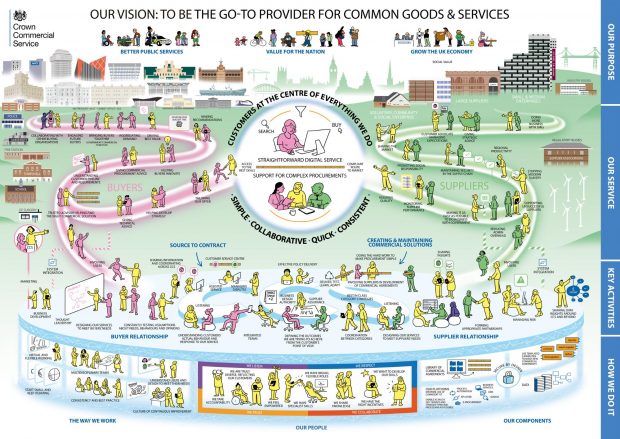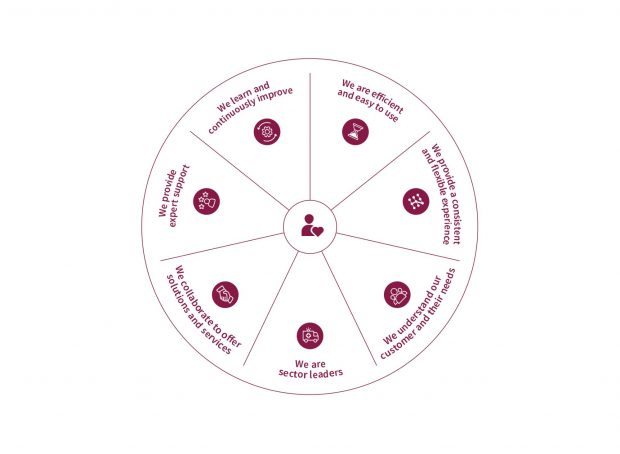Last year I wrote about how the Crown Commercial Service (CCS) was setting out on its transformation journey. CCS has aligned its transformation approach to the 7 Lenses of Transformation and in my first article I wrote about the importance of creating a Vision and the 6 things that had been learned through the development of the CCS transformation vision. A key feature of the CCS Transformation Vision is to put the customer at the heart of everything we do and I want to share how we have approached this.

Design is the second step in transforming organisations and for CCS it was critical that our design put the customer first. To do this we have adopted a four-step approach
- Start with research.
- Set the Principles and Standards for an improved customer experience.
- Pilot a customer experience redesign
- Create something that can be replicated.
Outlined below are details on each of these steps, along with some of the lessons we have learned.
Start with research
Organisations often embark on a transformation led by one specific driver whether it be cost reduction, technological transformation, growth, diversification etc. More often than not, these rarely are informed by key research into what various stakeholders want whether they be shareholders, customers or employees.
With the strategic ambition of doubling the spend that goes through CCS Commercial Agreements over the next few years, we wanted to make sure that we created an organisation for the future that was based on our customers immediate and changing needs.
To do this, prior to finalising our transformation Vision we ran a customer experience review that was focussed on getting an unfiltered and unhindered view from our customers. This review captured research from all areas of the Public Sector and consolidated the findings into a report that defined four Key Themes of the experience our customers want from us.

Set Principles & Standards for the experience we would like to create
The next step was to use the findings from our research with CCS customers to define a set of Principles and Standards for the experience we would like to create. This was done by defining the service standards that our customers have told us they want and impacting them against a base operating framework (the core customer processes within our organisation). Throughout this process there were consistent things that came up time and again. These were consolidated into a set of Principles that we can apply across the entire organisation and act as a ‘north star’ in delivering the experience our customers want.

Once complete, we had a baseline and framework that we could use as a test in a Pilot for running a new experience design. A critical next step before we undertook this was to run research sessions with CCS colleagues to get input into the Principles that had been defined. This was critical for 2 reasons:
- It helped us refine and validate what customers had told us based on what the business saw on the ground;
- It provided a key engagement opportunity to allow for CCS colleagues to input into the development process.
The outcome of this ended up with a consolidation, simplification and sharpening of a set of Customer First Principles that could be used as a framework to underpin all future CCS transformation design.
Pilot a new experience design
With the new Principles and Standards to hand, we wanted to undertake a Pilot to test a full experience design. This required a multidisciplinary team drawing together colleagues from across CCS.
Over a short period we undertook a number of key activities including:
- Analysis (market research and customer segmentation)
- Research (customer research)
- Defining the future service (account treatments and service standards),
- Experience mapping (end-to-end journey mapping)
- Operating structure design needed to enable the experience (roles & responsibilities, RACI, process & procedures and KPIs).
The output of this was an Experience Blueprint and Experience Maps that could then be taken forward into a set of planning activity to define the implementation plan, resource requirements and expected outcomes. In addition, we were able to begin assessments of wider ongoing change projects within the organisation against the Customer First Principles to ensure all change is aligned to create a consistent experience and putting the customer at the heart of everything we do.
Create something that can be replicated
Two of the key themes from the research have been about developing a consistent and simple experience regardless of what customers come to us for.
Key to achieving this was undertaking the Pilot so that tools and techniques could be used, tested and then refined into an approach the rest of the business could then follow. This supports the organisation in redefining the end to end experience that they give our customers in a way that will create a level of consistency and simplification our customers have asked of us.
Lessons learned through the process
As an organisation, we have learned a number of key lessons through this process:
- Listening and engaging with customers creates a collaborative environment where we can validate existing knowledge, gain new insight and provides legitimacy / credibility to transformation activity.
- It is helpful to have a structured framework that enables the voice of the customer to be embedded within the design of organisational transformation. Setting customer First Principles adds clarity and direction to design activity and provides a way of measuring delivery successes.
- When looking to replicate and scale, further testing can be required in other areas of the organisation to better refine the framework and its application.
- Experience redesign is an ongoing journey, as markets evolve and customer dynamics change so could the experience they expect from CCS. Ongoing customer engagement and market awareness is key to ensuring the CCS experience is best in class.
- Challenging the status quo is key throughout the activity. Organisations often provide great variation in the way customers are managed, however, that variation is not always the experience the customer expects and therefore that variation should be challenged.